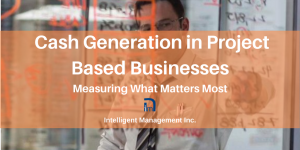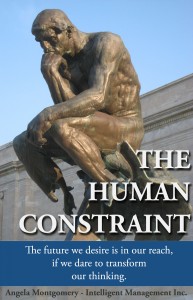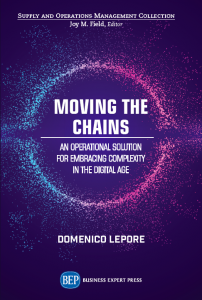
In any kind of business, the speed of cash generation through sales is crucial. This is something that cannot be measured by traditional accounting methods and balance sheets. These approaches do not take speed into consideration and that is odd because everyone knows that $1 earned in one day is very different to $1 earned in one week. It is a fundamental issue for economic sustainability. In times of crisis, this is more relevant than ever.
Fortunately, the Theory of Constraints was developed by a physicist, not an accountant, and so it takes speed into consideration and provides a way of measuring it. Throughput Accounting from the Theory of Constraints allows us to always know how the business is performing in terms of cash generation.
In other words, the right kind of counting radically improves focus on what matters to create growth. The Decalogue unites the Theory of Constraints with Deming’s vision of Quality, understood as a network of interdependencies oriented towards the goal. We build this network of interdependencies so that it maximizes Throughput by designing it around the constraint of the system. The constraint is the leverage point that allows us to maximize the value that the system is able to generate. By choosing the constraint strategically, we can direct and focus all the activities in the company towards the goal.
What follows is a summary of the main points underpinning Throughput Accounting.
Throughput
Throughput is the pace (speed) at which the system generates cash through sales. Speed= cash x unit of time.
What dictates the pace of completion of projects
Many companies sell products that require projects, i.e. a set of activities that are orchestrated to generate a result within a given budget, timeframe and quality standards (specifications) agreed with a customer. The constraint of every project is the longest chain of dependent events taking into consideration the availability of resources. This chain is called the ‘Critical Chain’ and it dictates the pace (speed) with which a project-based company generates Throughput.
The variables
The variables that allow us to understand the pace with which the company is generating cash (Throughput) are:
- The sales price (Sales) and the moment when the cash is received
- The amount of cash paid to suppliers (and the moment when the payment is made) and spent to make the product (TVC, Totally Variable Cost – costs that we incur exclusively because we sell something)
- In the case of companies that pay an internal department for sales then this can be considered as additional TVC
What’s fixed
To transform materials and services purchased into products that we can sell we need staff and an infrastructure (fixed costs) and other supports to carry out company activities (investments). Fixed costs and Investments are Operating Expenses (OE). It’s what we need to transform raw material into products we can sell.
Fixed costs are, precisely, fixed: we incur them regardless of how much we sell. Investments, for the most part, are inevitable (computers, travel, marketing, consulting etc.): they are part of the expenditure associated with the business life of the company and, in most cases, need to be considered alongside fixed costs.
The equations
The equations of TOC are:
Tput = Sales – TVC
Net profit = Tput – OE
Cash Profit = T – OE – ∆I
In summary: if we want to know how much cash profit the company is generating we need to know, for any given period, if the money received (Sales – TVC) can cover OE. This cash is the real cash profit (money in the bank) that the company makes. This is the true margin generated by the company (on which of course tax must be paid).
Building a report that shows speed of cash generation
In light of these considerations, how can we create a reporting method that shows us the speed of cash generation?
Let’s remember that the goal of the report is to highlight the speed with which the company generates cash. If this is connected with the speed with which projects are completed, then we need to know how quickly projects can be completed with the resources available (OE). For this reason, the report needs to indicate how much of the Critical Chain has been completed in the length of time the report refers to and how much money it has been necessary to spend on suppliers. The greater the number of projects completed in the time period of the report, the higher the amount of cash that has been generated.
The emphasis has to be, then, on a correct scheduling and management of the projects.
Once this has been understood realistically, i.e. at finite capacity with the resources (competencies) actually available that are able to complete the maximum number of projects possible, then we have the possibility to understand which investments will help us increase the speed of execution and if the trade-off between the cash outlay to accelerate completion and Throughput generated is worth it.
To generate a report we must:
First action: categorize all the items to be accounted for in terms of what they really are: Sales, Tput (generated when delivered to client), TVC, Investments, Fixed Costs
Second action: connect the expenditure on suppliers (TVC) with the progress along the Critical Chain – this is the only progress we need to consider.
Third action: as OE is essentially fixed, we need to show how much progress along the Critical Chain has been made in relation to fixed cash outlay in the time period of the report, i.e. in that period there has been outlay for salaries, travel, marketing etc. NB This is radically different from allocating fixed costs to the project in order to create a “product cost” to set margins against.
In summary
To create a report that highlights cash generation we need to connect this cash generation to the operations that create it. For companies that generate cash through completing projects, we need to highlight
- How much cash the projects generate (Tput)
- How many projects we can do in the time period given the resources we have (OE)
Speed relies on focus and focus comes through knowing the key elements that actually make the difference.







Leave a Reply